Comprehensive Zorn Exhibit opens in SF, then NYC
Anders Zorn: Sweden's Master Painter
-
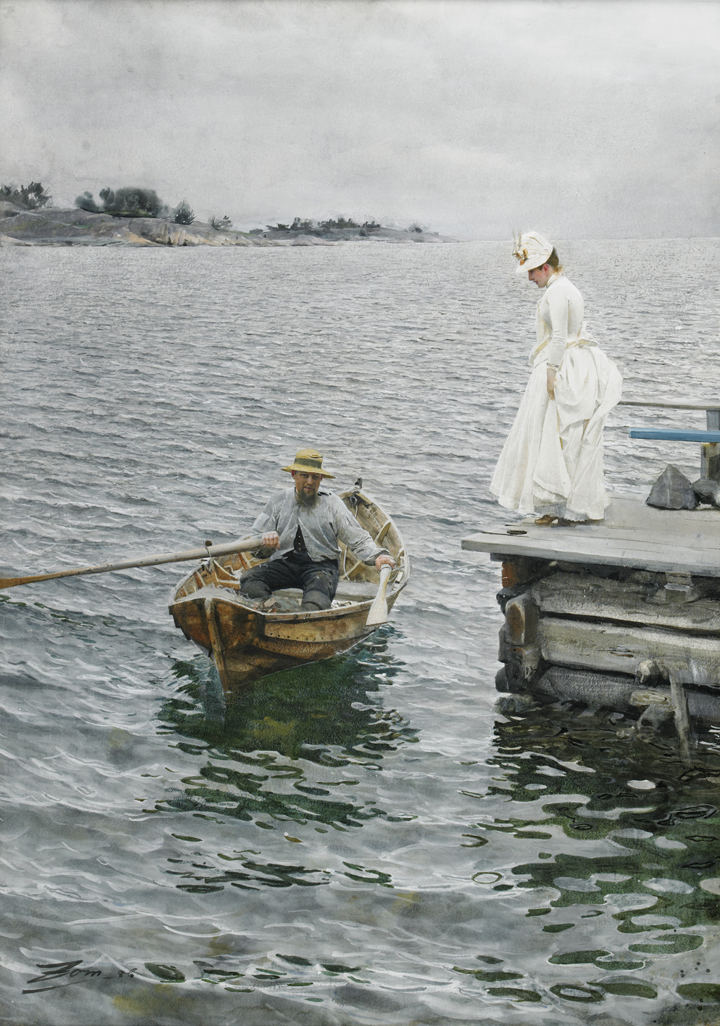 Anders Zorn (1860-1920), Summer vacation, 1886, watercolor (76x56cm), used by permission of the exhibit, “Anders Zorn: Sweden’s Master Painter."
Anders Zorn (1860-1920), Summer vacation, 1886, watercolor (76x56cm), used by permission of the exhibit, “Anders Zorn: Sweden’s Master Painter." -
-
Anders Zorn would have loved the soirée on opening night at San Francisco’s Legion of Honor fine art museum. In the grand salon, it included all the elements which he enjoyed. There were socialites, both men and women, attired smartly. There were many beautiful women dressed in traditional Swedish folk costumes. The refreshments were delicious and abundant, both cosmopolitan and tranditionally Scandinavian—down to the delicious meatballs in cognac sauce, cheeses and crudités, and delicious Scandinavian cookies. A trio of nyckelharpists provided a fine accompaniment to conversations.
Best of all, everyone was assembled to acknowledge Anders Zorn’s mastery and to celebrate his career in art. Guests viewed the more than one hundred exquisite pieces from the early to late years of Zorn’s career. As one of his contemporaries marveled: “He had the talent of Mozart, and the career of Napoleon.” Most importantly, this vast exhibition is a collection of works not likely to be reassembled again. -
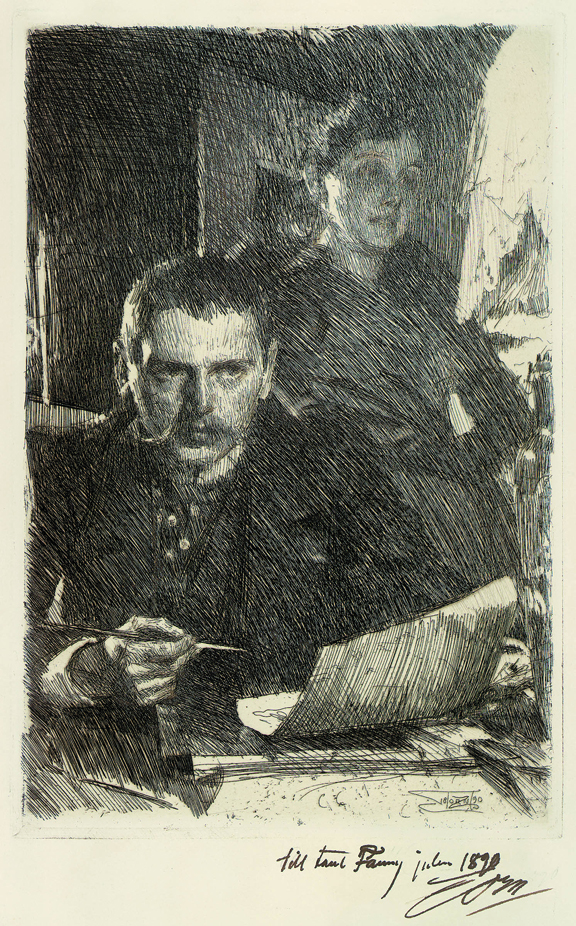 Anders Zorn (1860-1920), Zorn and His Wife, 1890, etching, used by permission of the exhibit, “Anders Zorn: Sweden’s Master Painter."
Anders Zorn (1860-1920), Zorn and His Wife, 1890, etching, used by permission of the exhibit, “Anders Zorn: Sweden’s Master Painter." -
-
A treasure trove
By great good fortune, not only do we have treasures from the Zorn Museum in Mora, but because this coincides with Stockholm’s national museum currently being closed for renovations, we have in this exhibit works which rarely if ever leave Sweden (the 1897 national treasure, Midsummer Dance), as well as a rare find from a private collection (Reveil, Boulevard Clichy, 1892). This beautiful watercolor, which was recently purchased at auction, is the hallmark for the show.
Here are works in all Zorn’s media and representing a span of his typical genres. From the most humble of beginnings in rural Mora, he began by drawing and whittling wood, wishing to become a sculptor. Recognizing his talent, locals would buy his portraits of them. He started by mastering watercolors, realistically at first (In Mourning, 1880); later, more impressionistically. His early work showed not merely his strength with portraits but his skill in depicting nature (Lucky with the Ladies, 1883-85). Oils were his next conquest, where he became particularly renowned for his portraits and scenes. Omnibus, 1891-92, won the prize in Paris and another treatment was purchased at the Chicago World’s Fair—where he was sent the next year as Sweden’s Art Commissioner.
In this exhibition you will marvel at how he can capture the glistening liquidity of water in watercolors (Summer Vacation, 1886). His composures are deft but his detailed surfaces of water are photographic.
Cosmopolitan artist
During his sojourn in France he quickly mastered engraving, allowing him, in the trend of the day, to make variations on his paintings and to sell multiple copies. He schooled himself on Rembrandt’s etchings, amassing the greatest collection of the master. New Year’s Card, 1890, cleverly announces this mastery of etching. On the right half of the card he engraves a self-portrait painting by Rembrandt that he bought; on the left, he engraved himself in the foreground with his mother and Emma on either side. What better comparison could he state? The layers and planes of his etchings, achieved only with black scratches (Zorn and his Wife, 1890)—by the density and curves of his lines rather than by cross-hatching—is astounding, particularly because in these etchings he depicts some subjects in shadow (The Waltz, 1891—another self-portrait with Emma).
He traveled to the U.S. seven times for commissions and exhibitions. These society portraits (Isabella Stewart Gardner in Venice, 1894) captured the wealthy in their accustomed settings, which are often as revealing as their personalities. These pictures made him wealthy enough to travel frequently for his art and reputation. These oils are often painted with verve and frequently with drama, though sometimes in repose. -
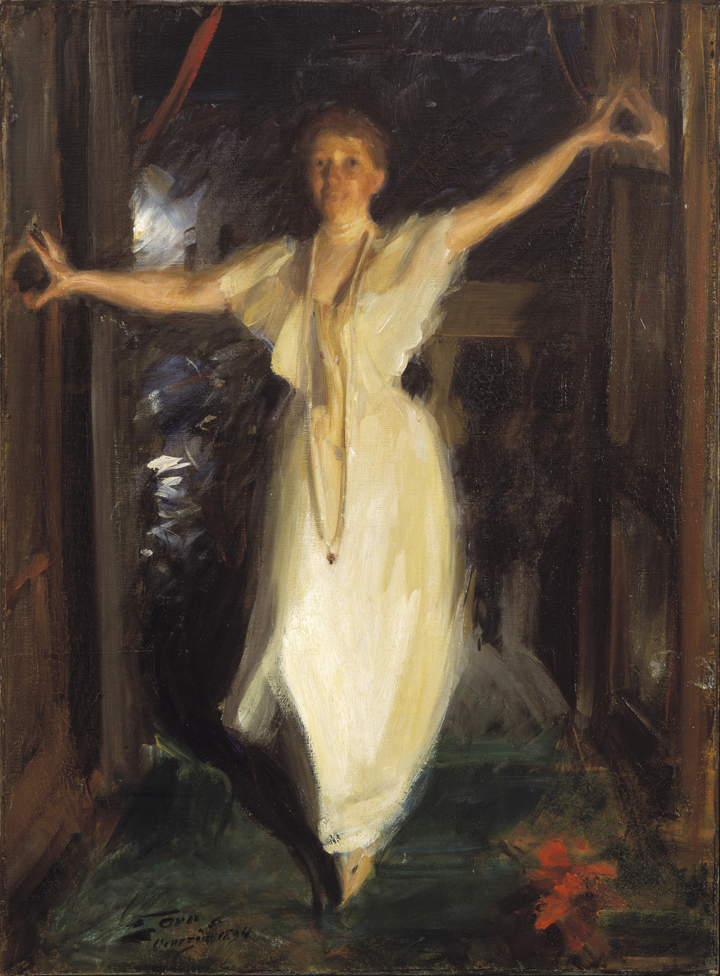 Anders Zorn (1860-1920), Isabella Stewart Gardner, 1894, oil, used by permission of the exhibit, “Anders Zorn: Sweden’s Master Painter."
Anders Zorn (1860-1920), Isabella Stewart Gardner, 1894, oil, used by permission of the exhibit, “Anders Zorn: Sweden’s Master Painter." -
Conserving folk wisdom
By the age of 36 he and Emma could retire to Mora, where he could indulge his passion for capturing rustic landscapes and life of the rural folks (compare Midsummer Dance with one of his later paintings, Dance in the Gopsmor Cottage, 1914). And of course there is his series of nude bathers. While he was reputed to be quite the womanizer, his pictures are far from the eroticism of Madison Avenue or swimsuit issues. Somehow, whether indoors or out, these paintings of nubile women capture not merely the luminous beauty of the commoner, but also the complementary values of nature or of rustic interiors. He catches time, place and person. Being free to paint as he pleased, he was not as concerned with sexuality as much as with form and texture and light. Rather than titillating, there is both an innocence and pleasure to these paintings: Une Premiere, 1888, is but one of his most famous of these.
The famous Self-Portrait in Red, 1915, has become so iconic that it is parodied in Swedish advertisements. But this too shows his well-earned pride of accomplishment as well as his humble beginnings. In Mora he preserved the traditional folkways, tools and techniques. Not merely did he collect old log buildings for his estate (the oldest in Sweden, 1282), but he rummaged for other artifacts. He became a great local philanthropist and conservator, even buying a famous old restaurant on Stockholm’s Gamla Stan, to prevent it from being demolished. Today the Swedish Academy of Arts meets there and gathers yearly to determine the Nobel prize for literature. His wife Emma, survived him by twenty years, burnishing his legacy, and leaving everything to Sweden and its people.
This exhibit is indeed a great introduction to Anders Zorn, and an invitation to Mora. -
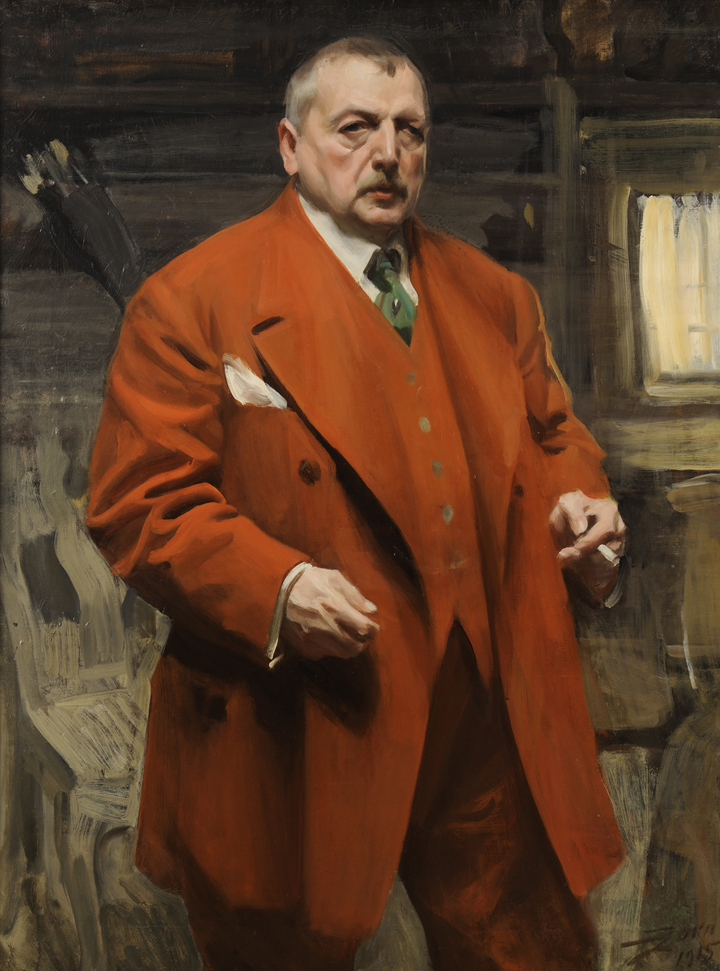 Anders Zorn (1860-1920), Self-Portrait in Red 1895, oil, used by permission of the exhibit, “Anders Zorn: Sweden’s Master Painter."
Anders Zorn (1860-1920), Self-Portrait in Red 1895, oil, used by permission of the exhibit, “Anders Zorn: Sweden’s Master Painter." -
Anders Zorn: Sweden’s Master Painter is the largest exhibition of his works outside Sweden, now at San Francisco’s Legion of Honor through February 2 (after which it travels to New York’s National Academy Museum, February 27-May 18).
Zorn travelled widely to study and to paint. He was an acknowledged master in drawing, watercolor, oil, etching and sculptures, and was one of the most famous and expensive portraitists in his time. He portrayed three U.S. presidents and captured the essence of many U.S. socialites. Yet he is unknown to many Americans, artists and art historians.
This happens to be a superb year for Zorn in America. Earlier in 2013 he was featured (“A European Artist Seduces America”) at the Isabelle Stewart Gardner Museum in Boston, covered by Nordstjernan. Now at the turn of the year, he’s featured in this exhibit on both coasts.
He painted with his friends, the Impressionists of France, even exhibiting in their great national exhibitions. Zorn's art hangs in their national galleries, and even in his 20s he was so esteemed by them as to be decorated with their Legion of Honor.
Thanks to the work of our indefatigable Consul General of Sweden Barbro Osher, an earlier planned exhibit of three painters now features only Zorn in this large retrospective covering all his media. Johan Cederlund, curator of Sweden’s Zorn Museet has assembled these painting with the curatorial assistance of our own James Ganz, curator of the Achenbach Foundation for Graphic Arts for the Fine Arts Museums of San Francisco, both of whom have written essays in the catalog. -
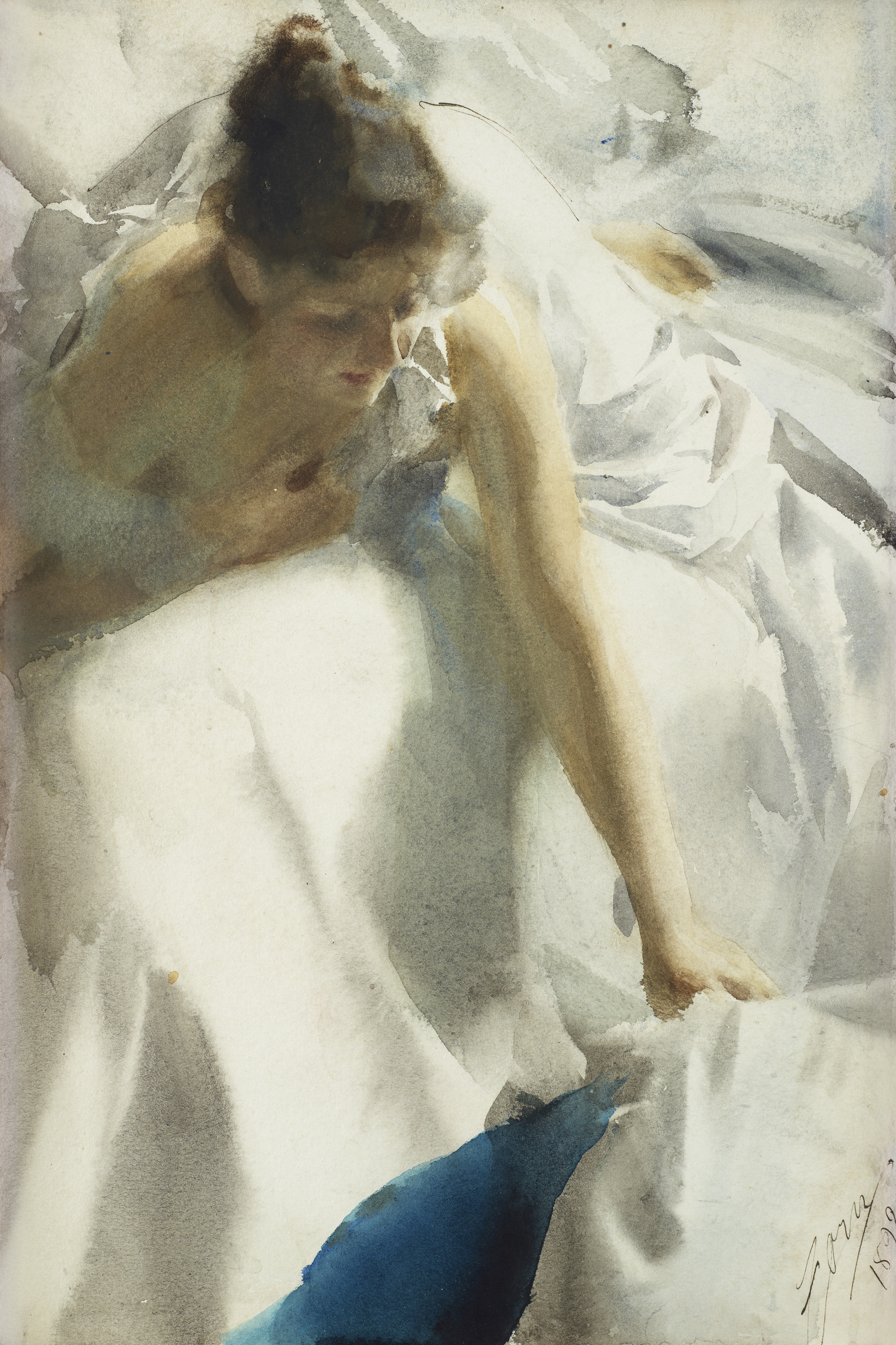 Anders Zorn (1860-1920), Reveil, 1892, watercolor, used by permission of the exhibit, “Anders Zorn: Sweden’s Master Painter."
Anders Zorn (1860-1920), Reveil, 1892, watercolor, used by permission of the exhibit, “Anders Zorn: Sweden’s Master Painter." -
Anders Zorn: Sweden’s Master Painter. November 9, 2013 – February 2, 2014. San Francisco’s Legion of Honor museum, Lincoln Park at 34th Ave. & Clement St. (415) 750-3600; www.legionofhonor.org
-
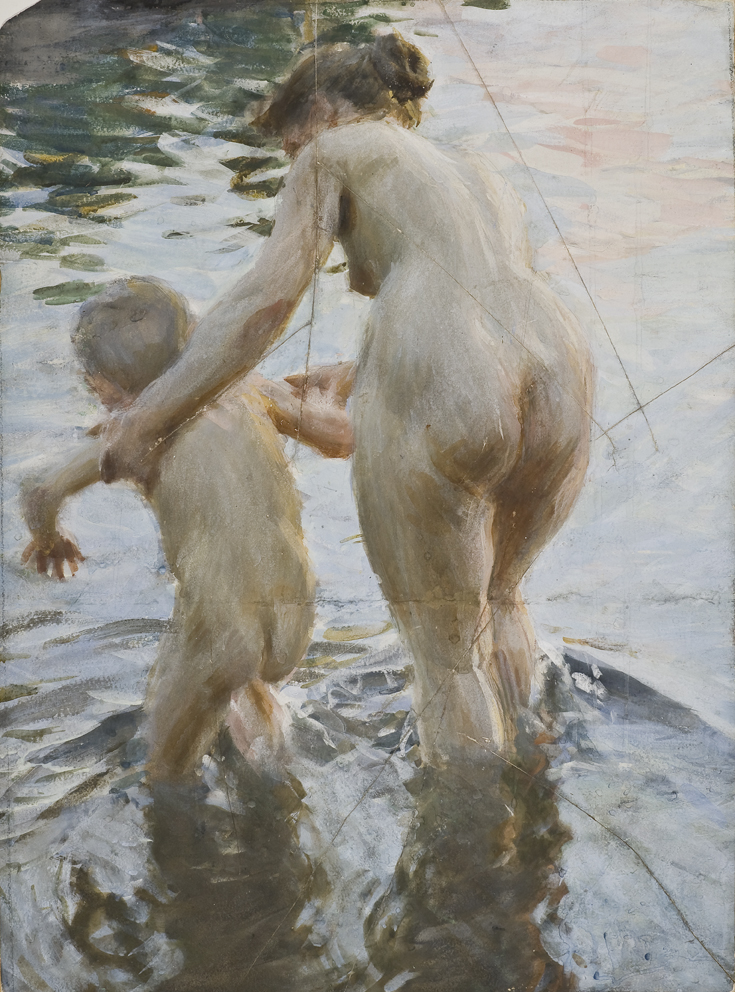 Anders Zorn (1860-1920), Une Premiere, 1888, gouache (76x56cm), used by permission of the exhibit, “Anders Zorn: Sweden’s Master Painter."
Anders Zorn (1860-1920), Une Premiere, 1888, gouache (76x56cm), used by permission of the exhibit, “Anders Zorn: Sweden’s Master Painter." -
~TED OLSSON
San Francisco -
-
